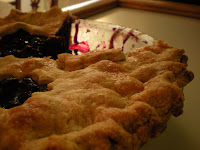
Does the universe seek balance, not entropy?
After bashing so much prepared tea, I found two places this past weekend that are actually worth the price of a cup.
The first was from the
Hampton Chutney Company (68 Prince St.), one of those New York places I love to hate.
Despite the fact that this place turns out probably the closest thing to a real dosa (basically a giant crepe, South Indian style) in Manhattan, it's ruined by the ridiculously incongruous fillings, like sun-dried tomatoes and smoked turkey; the tight-fisted, dime-sized portions of its namesake chutney; and its location, smack in the middle of the intolerable preening crowds of SoHo. The kicker? The most uncomfortable stools and tiniest counters imaginable (and no bathroom, of course), which makes navigating your way through a two-foot-plus, fingers-only dosa very tricky.
Namaste, my ass.
Imagine my skepticism, then, when I came in out of the pouring rain on Saturday, feet drenched, to sit while my guests had lunch. I figured it was time to give the place another try, so while they happily crunched their way through a few dosas, I took a deep breath and ordered a chai tea ($2.45) to warm up.
And it wasn't bad at all. Soothing, a bit creamy and not overly sweet; my only complaint would be in the timidity of the spices. Still, considering some of the other chai teas I've tasted, this was far from requiring a spit-take.
Hampton Chutney Company, you still annoy me to no end, but I will grace you with my presence on more rainy days when I've forgotten my umbrella.
It wouldn't be a true city summer day without a complete range of sensory input, from the weather to the food. As the sun battled its way out and the afternoon turned positively balmy, we ended up in Hell's Kitchen. And on a quiet side street, listening to the wind blow through the leaves, across from a real live nunnery, I found it: the iced tea I've been looking for, along with a few other things I didn't even know I was.
Cafe Forant (449 W 51st St.), where have you been?
This charming, airy little place has only been open for a year and a half, so I guess that's some excuse. But after just one gulp of the homemade cranberry iced tea ($2) and bite of the outstanding tarte tatin ($5.95), you'll be etching it into your culinary memory.

In my many tastings this summer, fruited iced teas have been the most difficult type to get right, and the lovely ladies who run this cafe absolutely nail it. The sour hit of cranberry and the strength of the black tea base dance together like an old couple at their 50th wedding anniversary, both comfortably and perfectly in step with each other.
I wasn't surprised to hear that the owners are in the process of getting this brew bottled. I just hope that works out, because it's a bit of a haul from Brooklyn just for an iced tea. It's worth it, though.
And even though it had me hitting every bathroom in Midtown for the rest of the day, I couldn't resist- all my companions' glasses of lavender lemonade ($2) just looked too good. So I ended up with one too, and I didn't regret one sweetly tart, perfectly fragrant sip.

It's important to have faith. Otherwise, it can never be rewarded.

 So when I found green tea yogurt ($.99) while waiting in a serpentine line at Manhattan's only and perpetually crowded Trader Joe's, I elbowed the smelly NYU students out of my way and pounced on it.
So when I found green tea yogurt ($.99) while waiting in a serpentine line at Manhattan's only and perpetually crowded Trader Joe's, I elbowed the smelly NYU students out of my way and pounced on it.
































